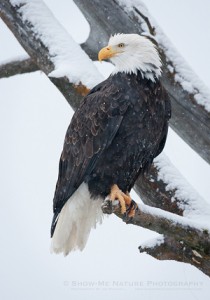
When temperatures are record-breaking lows (like right now), or wind chill advisories are in effect (like right now), it may be best to stay indoors. What makes the frigid temperatures I’m encountering on this trip even more of an issue, is the fact that I have to hike back into a canyon for about 3 miles to find the sheep. Then, of course, 3 miles back out. But tomorrow’s forecast is for warmer temperatures (in the 30’s), so I will be getting out tomorrow! So how do you prepare for shooting in cold, winter weather?
Dress in Layers
The first rule of working in the cold is to dress in layers. Several layers of lighter clothing works much better than fewer layers of heavier clothing. Think of adding or subtracting layers, while in the field, like a thermostat in your home. If you start getting cold, add more layers; if you start heating up, remove a layer. One thing you don’t want to do is to wear so much clothing that you perspire and dampen your clothing … not a good thing! You also don’t want to wear tight-fitting clothing; it’s best to keep the clothing loosely fitted.
And the number of layers will be influenced by your activity while outside. If you are constantly moving about, you will want less layers, to prevent perspiring. But if you will be sitting still, you will need more layers to keep warm. This is where layering can really make a difference!
Clothing of Choice
The materials you wear make a difference in your ability to maintain your body temperature. Some of the better winter materials include wool (merino wool is soft and comfortable) and fleece. Both are excellent as winter clothing. For outer clothing, something waterproof should be used. A down-filled parka works well at keeping the heat in.
No Necking
If your outerwear will not be covering your neck, you will want to wear a neck muffler or neck wrap. Fleece or merino wool work well here.

Be a Hot Head
Take special care to wear a hat, hood, or cap on the head. You may have heard that we lose most of our body heat through our heads. If it’s not extremely cold, I like to wear a fleece stocking hat: warm, lightweight and comfortable. However, if very cold, I have a nice “Elmer Fudd” hat that I wear. This is a hunting hat that allows you to snap the ear coverings on top of the hat when not needed, and folds down over the ears when it is cold. Even working in extremely cold temperatures, I find I have to occasionally remove the hat for a moment, in order to regulate the temperature and prevent perspiring! Wool and heavy, knitted hats also work well in cold weather.
Keep Those Piggies Warm
Cold feet seem to be my “Achille’s Heel.” It is very difficult for me to keep my feet, especially toes, warm in cold weather. Wearing two pairs of socks, a moisture-wicking “sock liner” under a pair of merino wool hiking socks is a good start. If that’s not enough, you can always add a foot/toe warmer (chemical activation), but be sure to place these on the outside of the sock … not against the skin!
The type/quality of boot can also help you keep warm. If you have cold feet, consider buying boots that are lined. And no matter the boot style, be sure they are waterproof! There are also battery-powered socks available, but I have not had much success with them.

Keep Those “Pinkies” Pink
You don’t want to have your fingers get so cold that they start changing colors! Frostbite is a serious issue and the fingers, along with toes, seem to be the first affected by frostbite. Therefore, gloves are mandatory! There are many kinds of gloves on the market and if you have found something that works well for you, then stick with it. I have found that a pair of wool, fingerless gloves, worn over a pair of glove liners (I use some that have silicone on the fingers, for better camera grip/handling) works up to moderately cold temperatures.
But once it gets “really cold”, I will add a pair of winter mittens (I like the OR (Outdoor Research) mittens) over them. The OR mittens have a glove liner velcroed inside them, but I remove them in lieu of using my own, fingered glove liners. When I’m ready to shoot, I simply slip the mitten off and shoot. You can use chemical warmers between the glove layers, but I find them cumbersome.
Miscellaneous Accessories
In extreme cold conditions, a face mask or a muffler wrapped around the face and over the nose can feel mighty good! Although not a warming device, if the landscape will be snowy/icy, I like to use Yak Trax over my boots to help maintain my footing (falling in snow/ice can get you wet).
That’s how I dress for those cold, wintry days. Do you have any special clothing/tips/tricks to add? If so, let us know.
Get more great tips in our free weekly newsletter.
 About the Author: Jim Braswell is a lifelong resident of Missouri, photographing nature in Missouri and beyond. His photographic passion is wildlife and wildflowers. When working with wildlife, his goal is to capture animal behaviors and actions. Besides photographing nature, Jim teaches photography and Photoshop at a local career center and participates in several art fairs/festivals every year. View more of his work on his website at: http://www.showmenaturephotography.com/
About the Author: Jim Braswell is a lifelong resident of Missouri, photographing nature in Missouri and beyond. His photographic passion is wildlife and wildflowers. When working with wildlife, his goal is to capture animal behaviors and actions. Besides photographing nature, Jim teaches photography and Photoshop at a local career center and participates in several art fairs/festivals every year. View more of his work on his website at: http://www.showmenaturephotography.com/

Leave a Reply